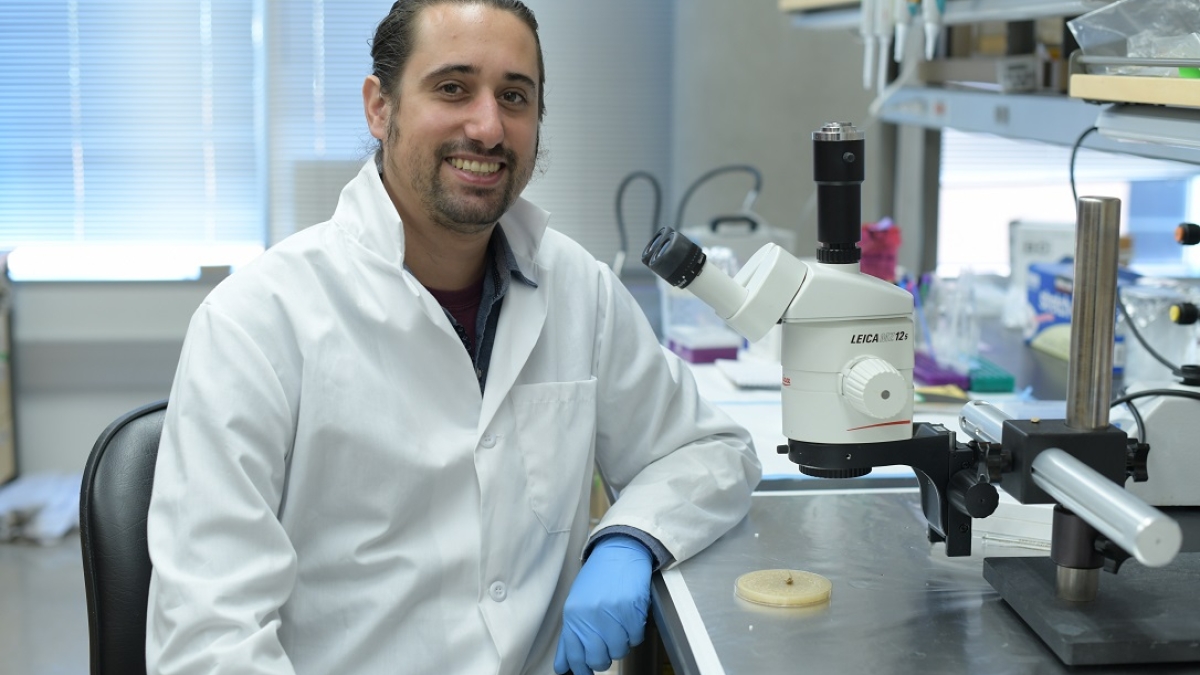Fascination with complex societies leads evolutionary biology PhD to bees

School of Life Sciences graduate Gyan Harwood studied honeybees with Gro Amdam while obtaining his PhD in evolutionary biology. He will continue to work with honeybees during his postdoctoral work. Photo by Samantha Lloyd/ASU VisLab
Editor’s note: This is part of a series of profiles for fall 2019 commencement.
Gyan Harwood was always fascinated by ancient civilizations.
While pursuing an undergraduate degree in biology, he also took several history classes, intrigued by how civilizations construct societies and manage their territories.
On a whim, he decided to add an animal behavior class to his course load and discovered that he didn’t have to leave biology to learn about fascinating complex societies. In fact, he could create one in a lab with a hive.
“I learned about eusocial insects, like ants and bees, and was absolutely blown away by how intricate and complex their societies were,” Harwood said. “Here, at last, was a way to combine my interests in studying biology in the context of complex societies.”
This led him to Arizona State University’s School of Life Sciences and its world-renowned social insect group, where he studied with Professor Gro Amdam. In his time at ASU, Harwood, who is graduating with his PhD in evolutionary biology, discovered colony-level immunity in honeybees, which allows workers to transfer to queens immunity that can help protect larvae.
This discovery is paving the way for the development of vaccines that can help protect declining honeybee populations from dangerous pathogens. He will continue to study honeybee populations in his postdoctoral work.
Question: What’s something you learned while at ASU — in the classroom or otherwise — that surprised you or changed your perspective?
Answer: The most eye-opening course I took at ASU was on microscopy. Up until then, I knew microscopes were useful for looking at small things, but I had no idea how far these machines had advanced in the last decade or so. The level of design and engineering that goes into each device is enormous, but what’s truly astounding is the amount of structural and physiological detail we can now observe in real time, including biochemical reactions.
Q: Why did you choose ASU?
A: I wanted to study the evolution of sociality in insects, and quite simply, ASU has perhaps the world’s best assembly of leading scientists in this field.
Q: Which professor taught you the most important lesson while at ASU?
A: My adviser, Dr. Gro Amdam, has been a tremendous mentor and has helped me grow as a scientist. Of the many skills she helped me develop, the one that sticks out most is how to effectively write complex scientific discussion in easily understandable and accessible forms.
Q: What’s the best piece of advice you’d give to those still in school?
A: Don’t be afraid to explore classes that don’t directly contribute to your degree. You don’t know what you don’t know, and sometimes learning about something unfamiliar can really open your mind to new ideas and perspectives that can help you grow as a person and a professional.
Q: What was your favorite spot on campus, whether for studying, meeting friends or just thinking about life?
A: The Diane and Bruce Halle Skyspace Garden outside of the Biodesign Institute. This quiet and shady space was an excellent space to come and gather my thoughts when I was designing experiments or writing.
Q: What are your plans after graduation?
A: I am continuing to study honeybees, this time looking at how they interact with viruses. I am a postdoctoral scholar at the University of Illinois at Urbana-Champaign.
Q: If someone gave you $40 million to solve one problem on our planet, what would you tackle?
A: As a honeybee scientist, my focus is on ensuring that these important insects can continue to pollinate our crops, but they face pressures from many diseases. If I had a $40 million research budget, I would work towards eradicating the viral and bacterial pathogens they face, as well as the parasitic Varroa mites that transmit many of these diseases.
Q: Describe some challenges or hurdles you faced while earning your degree, and what you did or what took place to overcome them.
A: There were certain laboratory skills I needed to acquire in order to carry out a branch of my research, but none of the ASU faculty were experts at using this technique with insect systems. Luckily, my adviser has a large network of contacts and put me in communication with a suitable colleague. I was able to visit their lab and use a generous training scholarship from the School of Life Sciences in order to acquire the skills I needed.
Q: What’s something you are most proud of during your time at ASU?
A: I’m proud that I helped discovery a colony-level immune pathway in honeybees. This discovery is being used by my collaborators to develop commercial bee vaccines that may one day help ameliorate disease pressure on these important pollinators.
Q: What’s next for you?
A: Back to the lab!
More Science and technology

ASU planetary scientist to be inducted into the National Academy of Sciences
The National Academy of Sciences is inducting School of Earth and Space Exploration Director Meenakshi Wadhwa into the 2023 class…

Unlocking the potential of AI for homeland security
“Can we do what we're doing now cheaper, more efficiently, more effectively?” Adam Cox, director in the Office of Strategy and…

SpaceHACK highlights student solutions to environmental challenges, digital divide
By Adrianna Nine About 250 students from around the world convened online and at Arizona State University on March 22 for the…